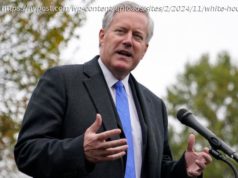A very basic guide to the scandal that would end Richard Nixon’s presidency.
« We’ve seen this movie before, » said Tuesday night, referring to President Trump’s mounting scandals about leaks to Russia and interference with the FBI. « It’s reaching Watergate size and scale. » He was hardly the first person drawing the parallel. I’ve written that the revelation that Trump asked FBI director James Comey to halt an investigation into a member of his administration was that forced him out of the presidency in the Watergate scandal. But what that conduct exactly — and how did the scandal itself come about? Veteran journalist Elizabeth Drew covered Watergate in real time, and her excellent book on that period — was recently reissued. In 2014, near the 40th anniversary of the resignation, she helped walk us through the trickier points of the scandal and its aftermath. Tim Naftali, the former director of the Nixon Library and current director of the Tamiment Library and Robert F. Wagner Archives at New York University, was also enormously helpful. Watergate burglar James McCord testifies before the Senate Watergate Committee. (Keystone/Getty Images) On June 17,1972, five men were caught attempting to bug the Democratic National Committee’s offices in the Watergate, a residential/office complex in the Foggy Bottom neighborhood of DC. Three of them were Cuban by background, a fourth was an American who had participated in the botched Bay of Pigs invasion, and the fifth was a former CIA employee. They were found with two listening devices, and two ceiling panels in an office adjacent to that of DNC chair Lawrence O’Brien were removed, suggesting that the burglars were attempting to bug O’Brien’s office. Alfred Cohen, the Washington Post reporter who covered the initial break-in, that the suspects were also found with « lock-picks and door jimmies, almost $2,300 in cash, most of it in $100 bills with the serial numbers in sequence … one walkie-talkie, a short wave receiver that could pick up police calls, 40 rolls of unexposed film, two 35 millimeter cameras and three pen-sized tear gas guns. » There were two open file drawers in the office when the burglars were caught, presumably because they were attempting to photograph documents. The break-in — the fourth such attempt, Drew says, with one previous break-in succeeding but not accomplishing the mission at hand — had been planned by Howard Hunt and G. Gordon Liddy at the behest of the Committee to Reelect the President (CRP) , Nixon’s campaign committee. Hunt was a veteran CIA operative who had been involved in the agency’s successful plot to overthrow left-leaning Guatemalan President Jacobo Arbenz and in the catastrophic Bay of Pigs invasion. Liddy was a former FBI agent turned aspiring Republican politician, who became close with the Nixon election team after a failed 1968 congressional run. Both were members of the team known as the White House plumbers — but more on that in a minute. Exactly what the burglars were hoping to find, through either photographing documents or bugging the office, is still somewhat unclear. Hunt they were looking for evidence that the DNC was receiving money from the North Vietnamese or Cuban governments. Liddy has recently the plan was to find information embarrassing to White House counsel John Dean. Perhaps the most popular theory is that Nixon was worried that O’Brien knew about his financial dealings with billionaire tycoon Howard Hughes, for whom O’Brien served as a lobbyist in addition to his DNC duties. A large loan from Hughes to Nixon’s brother had become an issue in the 1960 presidential race (which Nixon lost narrowly) , and when Nixon took office in 1969, Hughes reportedly gave him $100,000 (about $650,000 today) by way of the president’s friend Charles « Bebe » Rebozo, some of which, a report, went toward Nixon’s house in Florida. If that was in fact what the money was used for, it’d be natural for Nixon to fear what O’Brien could do with that knowledge. There is no smoking gun indicating that Nixon the break-in personally. As Rutgers professor and Nixon expert David Greenberg, CRP staff member and Watergate co-conspirator Jeb Magruder claimed to have heard Nixon authorize the break-in, but no hard evidence has turned up to confirm that allegation. However, Nixon certainly created an environment in which criminality was acceptable and even encouraged, and actively participated in covering up the crime. Howard Hunt in prison in 1978. (Michael Brennan/Getty Images) Far from it. Nixon’s operatives engaged in a whole bevy of criminal activity, much of it targeted at sabotaging his political opponents. His White House had an investigative unit known as the « plumbers » who were tasked with much of this. As White House aide Charles Colson to Nixon once, « We did a hell of a lot of things and never got caught. » One notorious plumber operation involved breaking into the offices of Lewis Fielding, the psychiatrist of Daniel Ellsberg. Ellsberg, as a government contractor, had contributed to a massive report on the war effort in Vietnam, detailing ways the Kennedy and Johnson White Houses had misled the public about the war, that would come to be known as the Pentagon Papers. He leaked it to the New York Times, the Washington Post, and various senators.; And there was more that simply never got unearthed. There’s of Colson bragging about blackmail efforts where even Nixon sounds surprised — but on the tape, Colson swears he’ll take those secrets to his grave, and he seems to have kept his word (Colson died in 2012) . Reviewing John Dean’s book, Bob Woodward that « the full story of the Nixon administration’s secret operations may forever remain buried along with their now-deceased perpetrators. » Woodward and Bernstein in 1974. (Hume Kennerly/Getty Images) The White House’s involvement was unearthed through a combination of government investigations into the break-in and investigative reporting by the Washington Post’s Carl Bernstein and Bob Woodward. Within days of the break-in, Bernstein and Woodward that one of the five men arrested for the crime, James McCord, had a contract to do security for the Republican National Committee, and had the burglars to Hunt, and Hunt to Colson. On August 1, they that a $25,000 check earmarked for the Nixon campaign made its way to the bank account of Bernard Barker, who was also arrested in the break-in. By September, they had a secret slush fund used by former CRP head and Attorney General John Mitchell to investigate Democrats, and by October they Segretti’s sabotage efforts. On September 15,1972, the five burglars, Liddy, and Hunt were by a federal grand jury. By January 1973 — after Nixon was reelected in a landslide, winning every state but Massachusetts and the District of Columbia — Hunt and the four of the actual burglars had pleaded guilty, and Liddy and McCord were after a trial. But John Sirica, the district court judge who tried these defendants, stated he was « not satisfied » the full story of the break-in had been told, and on February 7, the Senate to create a temporary (« select » in Congress jargon) committee, chaired by Democrat Sam Ervin of North Carolina, to investigate the break-in. It became clear that the conspiracy — and, in particular, the cover-up — reached higher in March 1973, when McCord to Sirica alleging a high-level cover-up and suggesting he feared retaliation if he were to « disclose knowledge of the facts in this matter. » That same month, L. Patrick Gray, the acting FBI director, during his confirmation hearings to become permanent director that he had provided White House counsel John Dean with files concerning the FBI’s investigation into the break-in, and that Dean had to investigators. From that point, it wasn’t long before senior aides to the president began to be forced out for their involvement. Gray himself resigned after it came out that he, at the behest of Dean and White House domestic policy adviser John Ehrlichman, had from a safe belonging to Hunt. On April 30, Nixon Dean and accepted the resignations of his chief of staff, H. R. Haldeman, and Ehrlichman, as well as his attorney general, Richard Kleindienst, while insisting that this did not constitute an admission of wrongdoing on the latter three staffers’ parts. By that point, however, Dean was with investigators, and would tell them that Nixon had actively participated in covering up the crime — an allegation later proven with tapes of White House conversations (but more on that later) . Richard Helms, the CIA director Nixon enlisted to obstruct the Watergate investigation. He would later be convicted of misleading Congress about the CIA’s role in the downfall of socialist Chilean President Salvador Allende. (AFP/AFP/Getty Images) It’s impossible to list all the varied ways the White House attempted to impair investigations from the grand jury, from the special Senate committee eventually formed to deal with the scandal, and from the independent counsel appointed to investigate the affair. But here are a few: Later, when it came out that there was hard tape evidence concerning Nixon and other aides’ roles in the cover-up, the administration took extraordinary measures — including going to the Supreme Court and attempting an unprecedented quashing of a Justice Department investigation — to prevent it from coming to light. But more on that in a sec. Of course. The period from 1972 to 1974 was generally excellent for American music, but you wouldn’t really know it from the singles charts. Case in point: The No. 1 record at the time of the break-in was Sammy Davis Jr.’s « The Candy Man, » which, while inspiring an years later, is mostly an enervating bit of treacle without much going for it: N It sold basically no copies upon initial release, but June 1972, the month of the break-in, saw the release of Big Star’s, my favorite record of all time and a power-pop classic.






